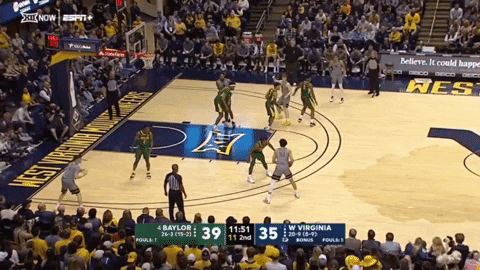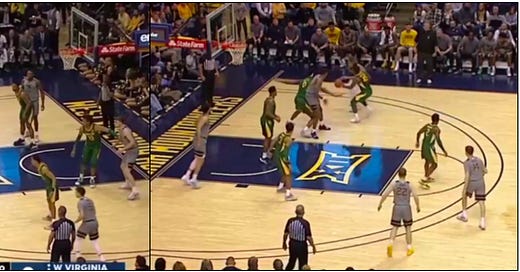Welcome back to the Hoop Vision Weekly!
It was a busy week here at HV headquarters. First, we released a new video over on YouTube detailing one of the top offenses from the 2019-20 season (more on that below), and then we sent out a new tutorial video to Hoop Vision Plus subscribers.
Now that we’re into the summer months, we will be moving the Hoop Vision Weekly to be sent out on Sundays, just as we did last summer.
Today is an especially loaded newsletter, as we wrap up the final chapter of our month-long series on offensive spacing.
In today’s edition:
Play animation tutorial for HV+ subscribers
Summary of the new BYU offensive breakdown
West Virginia and “Bully Ball”
The skills behind offensive rebounding
Final thoughts on the “Space Race”
Play Animation Tutorial (HV+)
If you have ever wondered how the different terminology and screens are animated during Hoop Vision videos, the new Play Animation Tutorial explains that process.

Video Outline and Timestamps:
0:00 Example of a play animation
1:47 Three reasons I started animating plays for HV videos
3:59 How the play animations have evolved over time
6:29 Intro to Adobe Premiere Pro
7:43 The basic process for animating text
10:48 Animating a screen/pick
13:34 Animating Michigan State's horns rub set
26:26 Final advice and when to use (and when not to use) for coaches
All three tutorials — made exclusively for HV+ subscribers — can be found at the links below. We will have more coming throughout the summer. Feel free to reach out directly with questions and ideas for future tutorials.
For full access to the tutorial and the deep archive of HV+ research, join Hoop Vision Plus today for $10/month or $100/year.
New Deep Dive: The BYU Offense
Back in February, we did three YouTube team breakdowns for Dayton, Baylor, and San Diego State. BYU was supposed to be next on the list, before the season ended prematurely.
The Cougars were one of the best offensive teams in the country this season. They finished first in three-point percentage (by a lot) and fifth in points per possession.
The 11-minute voiceover video below breaks down the scheme and players from Mark Pope’s first season as the head coach in Provo.
Video topics include:
Pistol DHO continuity BYU used early in the season
The switch to more traditional Continuity Ball Screen once Yoeli Childs returned from suspension (allowing for two bigs)
Thru action for TJ Haws
Different quick hitters and counters for TJ Haws, Jake Toolson, and Yoeli Childs
West Virginia and Bully Ball
In Big 12 play this season, West Virginia was dead last in the conference in effective field goal percentage. WVU’s 45.2% mark was the lowest by a Big 12 team since 2016 — when TCU posted a 43.5% eFG% and finished 2-16 in the league.
Even despite the historically poor shooting efficiency, West Virginia actually outscored their Big 12 opponents by an average of 3.7 points per game.
The reason? Bully Ball.
A combination of pressure defense, rim protection, and relentless rebounding led WVU to a top 10 finish in Ken Pomeroy’s adjusted efficiency rankings.
The five worst shooting teams (eFG%) to finish in the top 10 in kenpom:
West Virginia, 2020 (Bob Huggins)
UConn, 2011 (Jim Calhoun)
Temple, 2000 (John Chaney)
Auburn, 1999 (Cliff Ellis)
West Virginia, 2010 (Bob Huggins)
In the first part of this four-part series on offensive spacing, we showed examples of the West Virginia Triangle Hi-Lo spacing — a set where three players work together inside the paint for a post touch.
Even when running their flow/motion based offense, the WVU spacing was often jarring last season.

Both of the clips above show 3-out-2-in spacing for West Virginia, with players occupying both blocks/dunker spots. With that spacing, nearly all penetration by the WVU guards heads into congested space.
The clips above aren’t simply cherry-picked. We charted every field goal attempt taken by WVU during their final game of the season against Baylor.
On average, 2.6 West Virginia players were on the perimeter when a shot went up.
Like WVU, Baylor is one of the elite offensive rebounding programs in the country, as Scott Drew has tended to value size and strength over floor spacing. So naturally, we charted every Baylor field goal attempt from the game as well.
On average, 2.8 Baylor players were on the perimeter when a shot went up.
To better contextualize those numbers, we turned to a team on the other end of the spectrum: BYU.
The Cougars were one of the worst offensive rebounding teams in the country. Charting their final game of the season against Saint Mary’s led to the following insight…
On average, 3.6 BYU players were on the perimeter when a shot went up.
Pulling more on that same thread, the distribution of perimeter players for all three teams is shown in the table below.

The caveat here is that it’s only a one-game sample size, but it’s no surprise to see the extreme differences between BYU and the other two teams. BYU had at least three players on the perimeter during every single shot against Saint Mary’s.
Crashing the Glass
For coaches or teams committed to offensive rebounding, the key principle is usually “crashing the glass” — where a player leaves his area as soon as a shot goes up, to pursue the offensive rebound.
Establishing a crashing-the-glass mentality is arguably the most valuable thing a coach can do to increase offensive rebounding. (Insert “You can’t teach tall” cliche here.)
Drawing upon my own experience working on coaching staffs, we would chart missed crashes in both games and practices, which created punishments and incentives for our players.
But if you look at the offensive rebounding leaderboard, you won’t find many true glass crashers. Of the top 25 players in offensive rebounding percentage last season, 19 of them took five or fewer three-point attempts.
(Nate Grimes of Fresno State was the lone outlier in the group. The 6-foot-8 senior shot 87 three-point attempts and finished 24th in the NCAA in offensive rebounding percentage. No one else shot more than 14 attempts.)
With very few exceptions, the elite offensive rebounders aren’t glass crashers — they are already inside when a shot goes up.
West Virginia is one of the best examples of this. Oscar Tshiebwe (19.0%) led the entire country in offensive rebounding. Derek Culver (11.7%) was the Mountaineer with the second highest offensive rebounding percentage. The duo combined to shoot just one three-point attempt on the season.
Below is a typical WVU offensive rebound, with Culver — directly in the paint on the shot release — wedging Freddie Gillespie (an excellent rebounder in his own right) under the hoop.

That’s not to say West Virginia didn’t have glass crashers. Emmitt Matthews and Jermaine Haley (both 6-foot-7) filled that role for the Mountaineers.
In the clip below, West Virginia is playing (relatively) small with Matthews and Haley at the three and four spots, and you can see their glass-crashing mentality.

Haley (8.0%) and Matthews (6.0%) were fairly strong rebounders relative to their positions, but still well below the WVU frontcourt players’ rebounding rates.
How valuable is an elite offensive rebounder?
If we go back to the top 25 offensive rebounders in the country, the next question to ask is: Does having one elite offensive rebounder lead to overall team rebounding success?
The graph below plots the individual player’s offensive rebounding percentage on the x-axis and the team’s offensive rebounding percentage on the y-axis.

TAKEAWAYS:
21 out of 25 of the teams with top offensive rebounders finished the season above the NCAA average in offensive rebounding percentage
The average offensive rebounding percentage for the selected teams was 31.6%
The notable example here is Scottie James and Liberty. James finished sixth in the country in offensive rebounding, but Liberty finished 294th as a team.
Liberty head coach Ritchie McKay’s teams have been especially poor at offensive rebounding throughout his career, which is partially due to offensive spacing, but also from prioritizing transition defense. In this specific case, Scottie James’ individual rebounding ability only moved the needle so much for his team.
Final Thoughts on the “Space Race”
The basketball analytics movement has a tendency to be reduced to a specific philosophy: Embrace the three, space the floor, and avoid post-ups and mid-range.
To be fair, that basic pace-and-space philosophy has historically been a glaring market inefficiency. Just watch a game before the mid-2000s and the inefficiency is right in your face; the game looks entirely different.
However, the basketball analytics movement isn’t about one particular style of play. It’s about using data and evidence to drive decision-making. These decisions don’t have one size fits all answers — especially at the lower levels of basketball.
Let’s take a step back and look at this through a different sporting lens. Back in January, the godfather of sports analytics tweeted about speed in baseball.

On many ground balls in the MLB, the batter’s speed is irrelevant. MLB infielders are so good at their jobs, even the fastest players in the league hardly increase the difficulty of a routine ground ball.
There is a similar corollary between the NBA and size/athleticism. With just 30 teams in the NBA and limited roster spots, size and athleticism is a pre-requisite for making the league in the first place.
On top of that, the overall skill level and shooting ability of NBA players limits the value of aggressive schemes. The NBA is not a league full of press defenses, trapping zones, or even aggressive denials for a reason.
The “Grit and Grind” Memphis Grizzlies — maybe the NBA team with the most Bully Ball tendencies over the last decade — rebounded 31.0% of their missed shots and turned opponents over on 15.2% of possessions during the 2012-13 season.
The Grizzlies ranked second in the NBA in both of those categories that season, and yet Bob Huggins — by comparison — has never had a team with numbers that low. This season, West Virginia rebounded 40.1% of their missed and turned opponents over on 22.4% of possessions.
A college team can simply overwhelm with size and athleticism in a way that an NBA team cannot.
That’s not to say Bully Ball teams can’t make marginal improvements by blending aspects of a more modern approach. Anecdotally, a large chunk of Bully Ball coaches seem to be especially ambivalent to analytically-friendly shot selection — even when accounting for personnel.
But successful college basketball teams come in all different shapes and sizes. Making blanket declarations that teams should simply “play smaller” or “play bigger” ignores the nuance of the sport.
———
That’s a wrap on our four-part offensive spacing series. You can find the rest of the series at the links below:
Part One: The Space Race — the shift towards 5-out offenses and the tradeoffs between shooting and the other four factors.
Part Two: Same Scheme, Different Shots — why good spacing is only as powerful as a player’s ability to draw defensive attention.
Part Three: 5-Out Offensive Concepts — the actions and concepts being used by 5-out teams
If you enjoyed the series, please consider supporting the newsletter by becoming a Hoop Vision PLUS subscriber.
A subscription ($10/month or $100/year) gives you full access to the deep archive of HV+ research and tutorials, and allows us to continue to produce HV content on all of our platforms.


